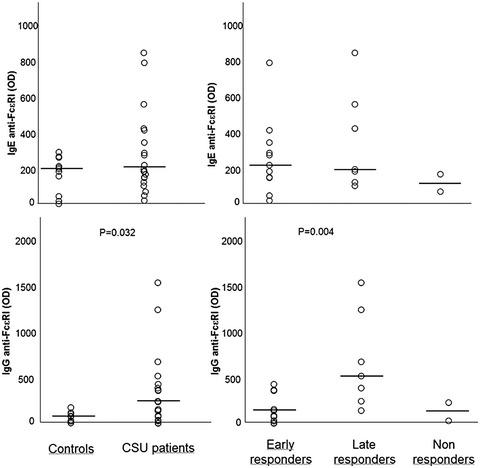当前位置:
X-MOL 学术
›
Clin. Exp. Immunol.
›
论文详情
Our official English website, www.x-mol.net, welcomes your
feedback! (Note: you will need to create a separate account there.)
Co-occurrence of IgE and IgG autoantibodies in patients with chronic spontaneous urticaria.
Clinical & Experimental Immunology ( IF 3.4 ) Pub Date : 2020-03-17 , DOI: 10.1111/cei.13428 R Asero 1 , A V Marzano 2, 3 , S Ferrucci 2 , M Lorini 4 , V Carbonelli 4 , M Cugno 3, 5
Clinical & Experimental Immunology ( IF 3.4 ) Pub Date : 2020-03-17 , DOI: 10.1111/cei.13428 R Asero 1 , A V Marzano 2, 3 , S Ferrucci 2 , M Lorini 4 , V Carbonelli 4 , M Cugno 3, 5
Affiliation

|
Chronic spontaneous urticaria (CSU) pathogenesis shows a complex and still unclear interplay between immunoglobulin (Ig)G- and IgE-mediated autoimmunity, leading to mast cell and basophil degranulation and wheal formation. The objective of this study was to evaluate at the same time IgE- and IgG-reactivity to well recognized and recently reported autoantigens in CSU patients, and to assess the effects of such reactivity on response to the anti-IgE monoclonal antibody omalizumab. Twenty CSU patients underwent omalizumab treatment. Urticaria activity score 7 (UAS7) was recorded at baseline and at different drug administration time-points for categorizing early-, late- or non-responders. At baseline, sera from the 20 patients and from 20 controls were tested for IgE and IgG autoantibodies to high- and low-affinity IgE receptors (FcεRI and FcεRII), tissue factor (TF) and thyroglobulin (TG) by immunoenzymatic methods. Antibody levels were compared with those of controls and analysed according to response. Eighteen patients were omalizumab responders (11 early and seven late), while two were non-responders. More than 50% of patients had contemporary IgE and IgG to at least to one of the four different autoantigens. Late responders showed higher levels of both anti-TF IgE and IgG than early responders (P = 0·011 and P = 0·035, respectively). Twenty-five per cent of patients had levels of anti-FcεRI IgE, exceeding the upper normal limit, suggesting that it could be a novel auto-allergen in CSU. In CSU, there is an autoimmune milieu characterized by the co-existence of IgE and IgG autoantibodies to the same antigen/allergen, particularly in late responders to omalizumab, possibly explaining the slower response.
中文翻译:

慢性自发性荨麻疹患者同时存在IgE和IgG自身抗体。
慢性自发性荨麻疹(CSU)发病机制显示免疫球蛋白(Ig)G介导的IgE和IgE介导的自身免疫之间复杂且尚不清楚的相互作用,导致肥大细胞和嗜碱性粒细胞脱粒并形成鲸鱼。这项研究的目的是同时评估CSU患者对公认的和最近报道的自身抗原的IgE和IgG反应性,并评估这种反应性对抗IgE单克隆抗体奥马珠单抗的反应的影响。20名CSU患者接受了奥马珠单抗治疗。在基线和在不同药物管理时间点记录荨麻疹活性评分7(UAS7),以对早期,晚期或无反应者进行分类。在基线时,测试了20位患者和20位对照的血清中针对高亲和力和低亲和力IgE受体(FcεRI和FcεRII)的IgE和IgG自身抗体,组织因子(TF)和甲状腺球蛋白(TG)的免疫酶法。将抗体水平与对照水平进行比较,并根据反应进行分析。奥马珠单抗有18例患者(早期11例,晚期7例),而2例无反应。超过50%的患者至少对四种不同的自身抗原之一具有当代IgE和IgG。晚期应答者显示出比早期应答者更高的抗TF IgE和IgG水平(分别为P = 0·011和P = 0·035)。25%的患者的抗FcεRIIgE水平超过正常上限,表明这可能是CSU中的一种新型自身变应原。在CSU中,存在一种自身免疫环境,其特征是针对相同抗原/过敏原的IgE和IgG自身抗体共存,特别是在对奥马珠单抗的晚期应答者中,
更新日期:2020-03-02
中文翻译:

慢性自发性荨麻疹患者同时存在IgE和IgG自身抗体。
慢性自发性荨麻疹(CSU)发病机制显示免疫球蛋白(Ig)G介导的IgE和IgE介导的自身免疫之间复杂且尚不清楚的相互作用,导致肥大细胞和嗜碱性粒细胞脱粒并形成鲸鱼。这项研究的目的是同时评估CSU患者对公认的和最近报道的自身抗原的IgE和IgG反应性,并评估这种反应性对抗IgE单克隆抗体奥马珠单抗的反应的影响。20名CSU患者接受了奥马珠单抗治疗。在基线和在不同药物管理时间点记录荨麻疹活性评分7(UAS7),以对早期,晚期或无反应者进行分类。在基线时,测试了20位患者和20位对照的血清中针对高亲和力和低亲和力IgE受体(FcεRI和FcεRII)的IgE和IgG自身抗体,组织因子(TF)和甲状腺球蛋白(TG)的免疫酶法。将抗体水平与对照水平进行比较,并根据反应进行分析。奥马珠单抗有18例患者(早期11例,晚期7例),而2例无反应。超过50%的患者至少对四种不同的自身抗原之一具有当代IgE和IgG。晚期应答者显示出比早期应答者更高的抗TF IgE和IgG水平(分别为P = 0·011和P = 0·035)。25%的患者的抗FcεRIIgE水平超过正常上限,表明这可能是CSU中的一种新型自身变应原。在CSU中,存在一种自身免疫环境,其特征是针对相同抗原/过敏原的IgE和IgG自身抗体共存,特别是在对奥马珠单抗的晚期应答者中,









































 京公网安备 11010802027423号
京公网安备 11010802027423号